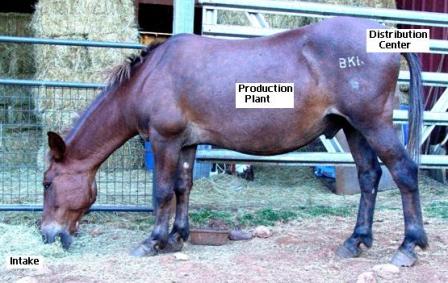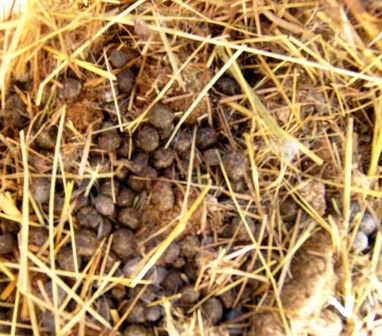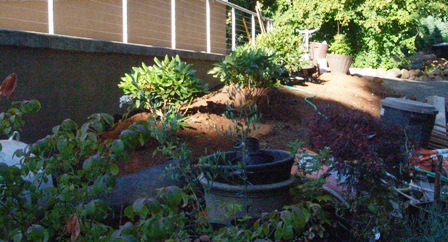At last we are given permission to do some landscape repair! The big feet have finished tromping on the north-side border of the house, the various machines of construction have finished compacting the soil there, the piles of assorted cast-off but perhaps valuable materials have moved onto the parking area, the wall has been painted, and I heard the words, “Sure, you can put in some plants.”
Easy to say. Here is what they left us to work with:
Much as I have chafed and fretted for this day, it was not with a glad heart that I looked on the wreckage of soil north of the house. Was this topsoil? Bottomsoil? Upsidedown soil? Who could know? Given its red clay base and adobe-like qualities, we decided to launch right into renovation before planting. Nothing is as discouraging as a garden planted in poor soil, and nothing is as difficult as repairing it after planting. So we fetched up the tiller from the vegetable garden and went to work on a dirt cocktail.
What are your ingredients, ask the mixologists? They are some good manures and a dash of salt. The salt comes from your brow as you mix.
Here, for instance, is mule poo in its native environs:
William, our mule, is an able producer of this material. Unlike horses, who drop their leavings wherever they happen to stand, a mule has a tidy way of arranging skeins of apples in latrine areas. It makes collecting so much easier! The quantity of product delivered is impressive. Here’s an illustration of the processor:
This year’s mule manure has an assertive grassy nose, with a background of barnyard, and a faint air of fungus underneath. Earthy and dark, its overtones are firmly equine, but the careful connoisseur will detect the difference: a mule is not a horse, nor is it a ass. This age-worthy product is unique and pleasing in its bouquet.
Furthermore, it’s full of little, partly digested-up grassy bits.
Aside from the usual components of fertilizers (Nitrogen, Phosphorus, Potassium: NPK), the grassy bits in equine manure are wonderful for soil texture. So, after we had raked off the surface gravel, and picked up the nails, screws, hunks of re-bar and other mysterious objects, we wheeled in barrow-loads of mule manure.
Here I am, delivering a measure of mule poo from our woods.
One at a time, barrow after barrow. I note: the house is uphill from the woods. The wheelbarrow is empty going down, loaded coming up. This is the wrong plan, but I’m not sure how to fix it.
Once sufficient jiggers of mule had been brought to the bed, we tilled it in. This is shaking and stirring all at once. We were cheered at the result. The rear-tine tiller breaks the manure apples and digs deeply. By the time we had finished, late in the day, the soil was looking lose and serviceable. The shovel sank to its shank with an easy push. We smiled at each other.
The cocktail is not finished, however. In the area where each major shrub will go, we bought in a shoveling of rabbit pellets. All manures are not alike, you must know. Rabbit manure is much higher in nitrogen than the mule manure, and is rich in phosphorus as well. The first is good for green growth, the second for flower formation. As it happens, we have a ready source of rabbit droppings.
Here is recent production, a sort of fumier nouveau for the discerning user.
It is entirely more assertive than the vintage we examined above. In the nose you will find a distinct aroma of ammonia. Some might call this an austere character, but its simple herbal sweetness refined by a grassy bouquet rescues it. As it is a nouveau, we expect a certain greenness, but rabbit is never harsh.
And there you have it. By the time we set the young rhododendrons in place as foundation plants to future development, the dash of salt had been thoroughly worked into the recipe. Dig well, improve tilth, provide nutrient, and irrigate deeply, and those rhodies should have a good start.
(There will be a hydrangea at the far end of the bed, but, frankly, we were too pooped to put another plant.)







The new plants must be drunk on the lovely soil cocktail they have been immersed in. By next year they should all be a vision, not of drunken squalor, but of verdant splendor.
Verdant splendor sounds good. Let’s hope for that!
S.
By the way what are you calling it? A Mulgarita? or a Bunny Hop?
Hmm. I like ‘Mulgarita.’ Let’s go with that. Thanks!
S.
Wah!!! I want my own mule!!!
Available at your corner market, George. I’m sure you can find one. (Didn’t you make this same complaint last year? Take control of your life!)
S.
The bit o’salt is absolutely essential.
In my old garden, I dug up the plants, dug a trench about 50 cm (1.5′) wide, 4 m (4 yds) long and perhaps 50 cm deep. Took me a week. Then the horse manure from the stables a bit uphill from the garden were brought in … with a front loading tractor.
Cheating, is what I call that. I fully expected Mr. horse owner to bring it himself, by the wheelbarrow, so he could join the fun 🙂
Cheating, indeed. But you put in your salt equity on the site preparation. I’m betting the results were testimony to the effort. Maybe by the time you come to visit these plants will have some stature. At the moment, they look like beads on a string.
S.
As much as I’m sure she would like to leave the impression that she was moving as fast as the fourth picture down from the top suggests she was, as the photographer, I can attest that the uphill climb had taken its toll. Mind, I’m not complaining. It was a Herculean labor to move all that poop UP the hill from Birnam Wood. Of course, as the male component of this holding, I had nearly automatic dibs on the tiller thus avoiding the wrong end of the barrow on the long uphill trek.
Also, Susan, as one whose salt was liberally mixed in the Mulgarita, I’m cheered that you could make me smile while reading your account of that long afternoon. Should we admit that we repaired to the Barby and wolfed down two, large steaks as compensation?
We were protein-starved. We required it.
S.